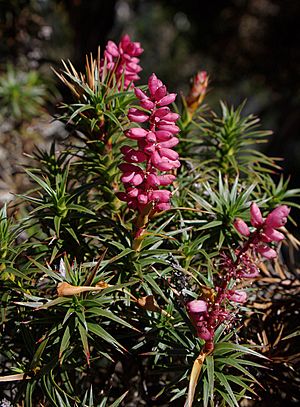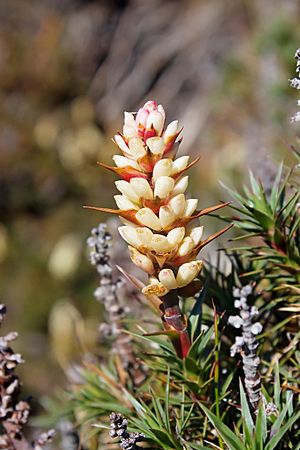Richea scoparia facts for kids
Quick facts for kids Richea scoparia |
|
|---|---|
 |
|
| Richea scoparia flowering in Mount Field National Park, Tasmania | |
| Scientific classification | |
| Genus: |
Richea
|
| Species: |
scoparia
|
| Synonyms | |
|
Richea angustifolia |
|
Richea scoparia is a special plant found only in Tasmania, Australia. It was once known as R. angustifolia. This plant belongs to the Richea group, which is part of the Ericaceae family. Plants in this family often look like small, bushy shrubs. People often call Richea scoparia the honey bush or just 'scoparia'. It gets this name because it grows upright and bushy, like a broom. Many hikers know this plant well!
Contents
What Does Richea Scoparia Look Like?
The Richea scoparia plant usually grows to be about 1 to 3 meters tall. You can often find it in windy mountain areas. Its leaves stay on the plant for many years, even after they have died.
The leaves are packed closely together, sharp, and shaped like a narrow spear. They have a wide base that wraps around the stem. Each leaf is about 3 to 6 centimeters long.
Flowers of the Honey Bush
The flowers grow in spikes at the end of the branches. These spikes are about 4 to 12 centimeters long. The flowers can be many different colors, including orange, yellow, red, pink, or white. They bloom from January to March.
Each flower has a cap made of joined petals. This cap falls off, showing the stamens (the parts that make pollen), which are about 5 millimeters long. There is also a short style, which is part of the plant's reproductive system.
Hybrid Plants: A Mix of Two Species
Richea scoparia can sometimes mix with another plant called Richea pandanifolia. When they do, they create a new type of plant called Richea curtisiae. This mixed plant is quite common in places where both R. scoparia and R. pandanifolia grow. It often appears after events like a fire or when land has been cleared.
Where Does Richea Scoparia Grow?
Richea scoparia lives in mountain areas, often above 700 meters high. It faces tough weather conditions for many months of the year. You can find it in the west, south-west, north-east, and Central Plateau regions of Tasmania. It grows in many different types of places in these high-altitude areas.
This plant grows slowly and has tough, leathery leaves. It is a perennial species, meaning it lives for more than two years. The way Richea scoparia grows and its shape can change a lot. This depends on the weather conditions each group of plants is exposed to. Strong winds, especially their speed and direction, greatly affect how fast the plant grows and how well it survives. In very windy spots, it often grows as a dense, rounded bush.
How Richea Scoparia Reproduces
Richea scoparia has a special relationship with a small lizard called the snow skink. This lizard helps the plant reproduce! The snow skink eats the nectar from the flowers. To get to the nectar, the skink removes the cap of joined petals from the flower.
When the cap is removed, the plant's reproductive parts are exposed. This helps more seeds to be spread and makes it easier for the plant to be pollinated. Scientists think this special interaction might have developed because of the harsh mountain weather. By working with the lizards' eating habits, the plant makes sure its caps are removed and its seeds can spread successfully.


